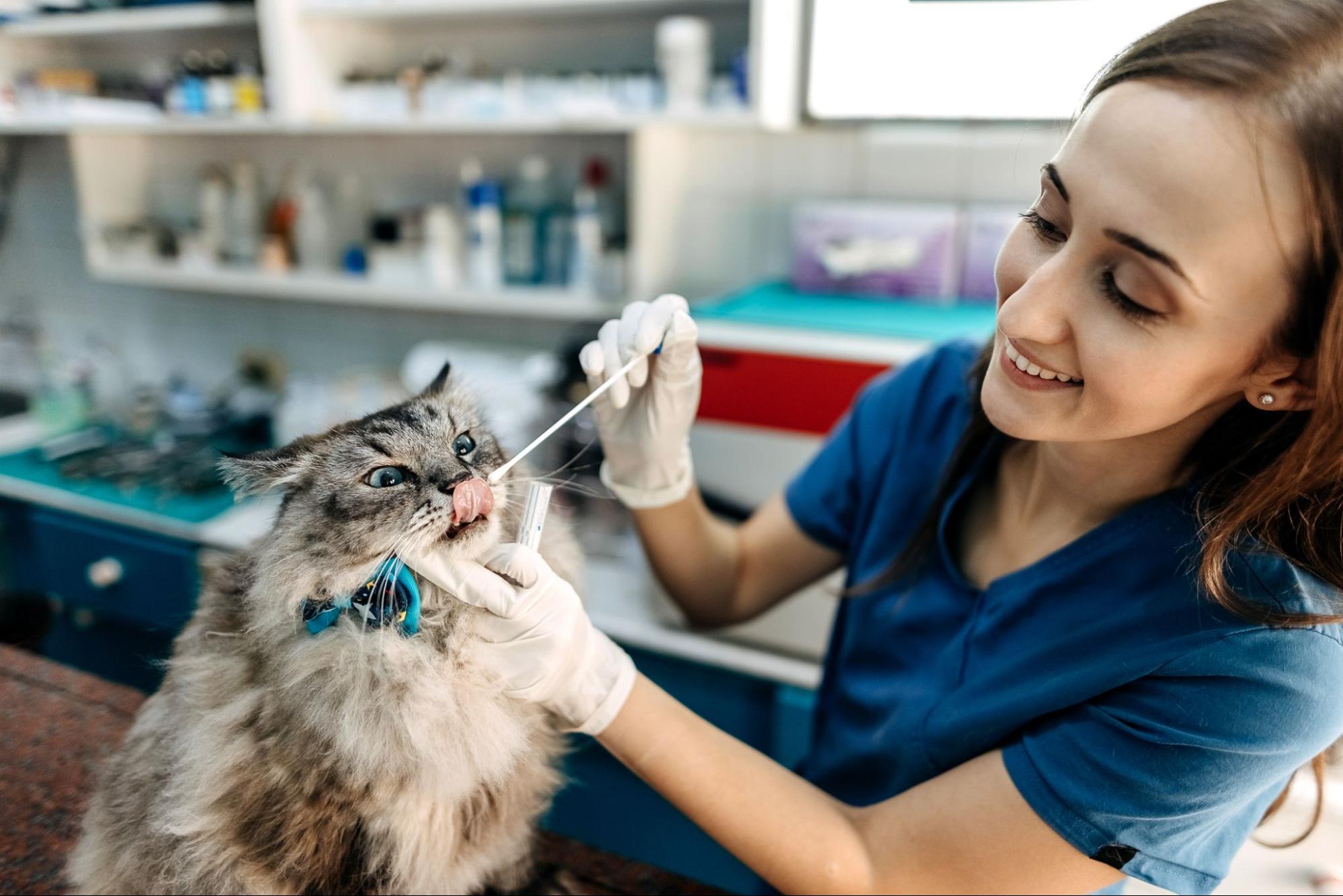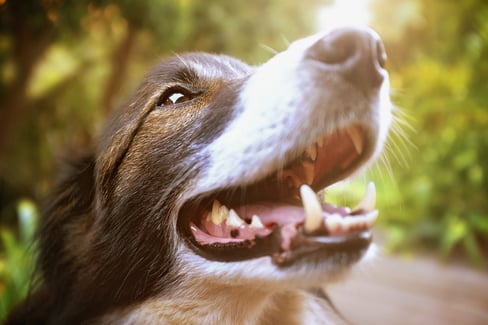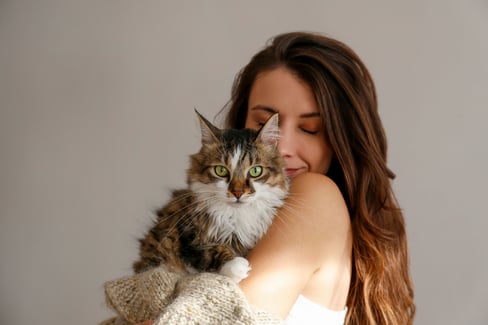Table of Contents
We all know that good dental hygiene is important. For most of us, the importance of brushing and flossing was drilled into us as children by our parents and our dentist. If you don’t do these tasks every day, the risk of developing dental diseases, such as gingivitis and cavities, significantly increases.
If we brush our teeth every day, why do we not do the same for our cats? Just like humans, cats accumulate plaque on their teeth (a bacterial substance left behind by their food) which if left, can eventually harden and develop into tartar (sometimes called calculus), a much harder substance that’s more difficult to remove.
Brushing your cat’s teeth might seem strange to them at first, but with patience and persistence, they will get used to the sensation.
The buildup of plaque and tartar can eventually lead to the following dental disorders in cats:
- Gum (periodontal) disease: Characterized by the infection and inflammation of the tissue surrounding your cat’s teeth, caused by the accumulation of plaque on and below the gum line. Periodontal disease causes inflammation of the gums, the ligaments of the teeth, and the bone surrounding them (jaw). Periodontal disease can cause tooth loss if left untreated because the tissues surrounding them have been compromised.
- Gingivitis: With gingivitis, your cat’s gums become inflamed, but the ligaments and bones surrounding your cat’s teeth aren’t affected. It can usually be identified easily because the gums change colour from a healthy pink to red or purple, indicating inflammation. With this disease, the gums usually bleed on contact, whether it be from brushing or eating. Thankfully, gingivitis is less serious than periodontal disease and can be corrected with professional dental teeth cleaning. However, if left untreated, gingivitis can develop into periodontal disease.
- Periodontitis: A more serious dental disease in cats where the tissue damage is more severe and includes the gums, ligaments, and bone surrounding your cat’s teeth, and occurs when plaque, tartar, and the resulting gingivitis aren’t treated. Periodontitis results in permanent tooth loss. Some cats can develop this disease very early in life, as early as one year old.
In this article, we explore more about cat dental care, including why it is important, how to spot issues before they become significant problems and tips for improving your cat’s dental health at home.
Why Is Dental Care Cat Health Important?
Just like people, cats accumulate plaque and tartar on their teeth. Plaque is basically just a buildup of bacteria in your cat’s mouth from their body, as well as the food they eat. This bacteria sticks to their teeth as a yellowish substance. If the plaque builds up too much or is left too long, it can harden into tartar. Tartar is much more difficult to remove than plaque because it’s much harder.
Dental disease in cats is also quite common. Between 50–90% of cats four years of age and older suffer from some form of dental disease. The most common dental diseases can be prevented by simply ensuring that your cat gets regular dental care.
Dental Disease Can Cause Severe Pain and Discomfort
The buildup of plaque and tartar in your cat’s mouth can eventually lead to various dental diseases that can significantly affect your cat’s quality of life due to pain and discomfort. Signs that your cat is in pain can be difficult to spot, mainly because they are so good at hiding their true feelings. Your cat could be eating and acting normal, not showing any obvious signs of pain or discomfort, making spotting dental problems tough. It’s usually only when the cat gets regular professional teeth cleaning that the owner can spot the behavioural difference afterward. This is because cats are masters at hiding their true feelings regarding pain, a skill they’ve developed from being in the wild. Cats have developed the ability to hide their pain because if they showed weakness to the rest of the colony in the wild, they’d be shunned. This is because weak or sick cats become a liability for the rest of the cats in the group because they attract predators. So, to survive, cats developed the instinct to mask their pain. This means that if anything, you might be able to notice small changes in their behaviour, but sometimes they can be so subtle that you don’t notice anything.
Untreated Dental Disease Can Spread to Other Parts of the Body
The mouth is an open path to the rest of the body—so it makes sense that if your cat has untreated dental problems, the bacteria in their mouth could potentially travel to the rest of their body through their bloodstream. The spread of bacteria from dental disease to other parts of your cat’s body can result in systemic effects, either from the bacteria itself or from your cat’s immune system’s natural response to the bacteria. The heart, kidneys, and liver are especially susceptible to the effects of oral bacteria.
Signs of Cat Dental Care Issues
There are a wide range of signs that you can look for to help you determine if your cat is in need of dental care:
1. Excessive Drooling
In some cases, severe dental problems in cats can prevent them from closing their mouth completely due to pain, which can result in drooling. While there are a number of other reasons why cats may drool, including being relaxed and content, if your cat is suddenly drooling all the time, that’s a good indication that a trip to the vet is in order.
2. Pawing at The Face or Mouth
In an attempt to relieve the pain, sometimes cats with dental issues will paw at their face or mouth. This is similar behaviour to trying to scratch or lick at another area of their body. They might also shy away when you try to touch their face or head when you’re petting them, which could be another indication that they are in pain.
3. Bad Breath (Halitosis)
Although a cat’s breath doesn’t exactly smell like sunshine and roses, a cat with dental issues will often have noticeably bad breath. This is because the bacteria in their mouths is going haywire. Just like a regular wound can have an unpleasant odor, the combination of excess bacteria, inflammation, and decayed tissue will often have a noticeable smell.
4. Dropping Food From The Mouth
If your cat has oral pain, they will likely have trouble eating, especially if you feed them dry kibble. You may notice pieces of food falling out of their mouths when they try to eat, or even them opening their mouth wide to try and “scoop” the food into it and swallow. If you notice any of these behaviours, it’s a good idea to get your cat checked out by a vet.
5. Bleeding Gums
If you can manage to look inside your cat’s mouth and you notice a dark red line on your cat’s gums, inflammation, or obvious bleeding, then your cat is suffering from dental problems. Usually, bleeding gums are a sign that’s recognized as a result of another more obvious sign, like bad breath, that causes the owner to check their cat’s mouth to see if they can see the source of the issue. However, you may also notice some blood left behind in your cat’s food bowl from the last time they ate.
6. Not Wanting to Eat Or Avoiding Harder Foods
Because eating is painful for a cat with dental problems, they may avoid eating altogether or prefer to eat softer foods, like wet food, over dry, because they don’t have to chew it. If your cat suddenly doesn’t want to eat their favourite crunchy treats or food, then that could indicate that they have oral pain that needs to be addressed.
7. Visible Tartar
Plaque can sometimes be removed from cats’ teeth naturally when they eat or when their rough tongue comes into contact with their teeth. However, over time, plaque can harden into tartar. This happens when the plaque absorbs minerals from your cat’s saliva and the gingivitis bacteria. The hard surface of tartar provides the perfect environment for additional bacteria to attach to, which develops into plaque and ultimately adds layers to the tartar buildup, making the dental disease your cat is experiencing worse.
Consequences of Poor Dental Care for Cats
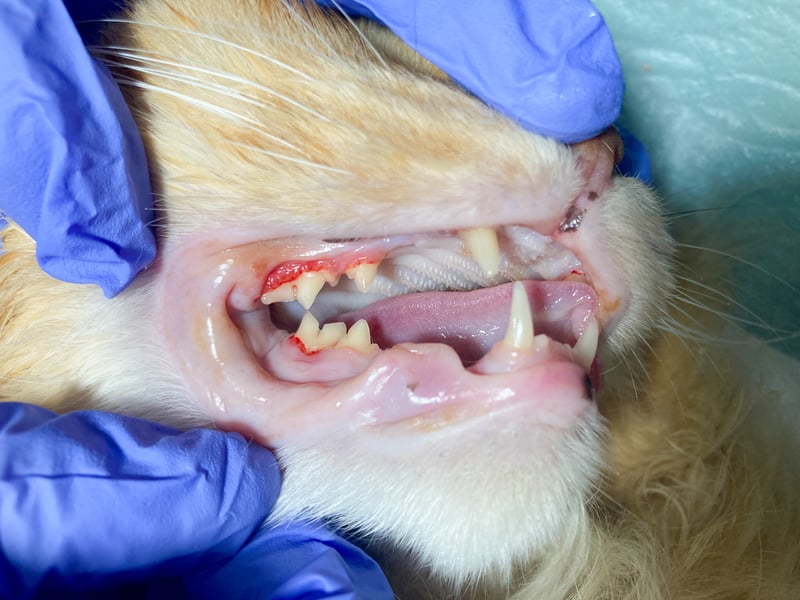
Cat dental care is essential for ensuring that your cat remains in good health well into its golden years. Neglecting your cat’s dental health can have a variety of different consequences, including serious disease and a reduced quality of life.
1. Chronic Dental Disease in Cats Can Lead to Cancer
If left untreated, dental disease in cats can lead to oral cancer. There are a few different types of oral cancers that can develop in cats, as outlined in the table below:
|
Oral Cancer in Cats |
Description |
|
Oral Squamous Cell Carcinoma |
This cancer originates in the squamous cells lining your cat’s mouth, which are found in the gums, tongue, and back of the throat. While there are several potential causes of this cancer, including genetics and exposure to carcinogens, chronic inflammation due to poor cat dental care is one of them. If the cancer is caught early, the prognosis for your kitty is improved, but if it isn’t caught early enough, the veterinarian may recommend palliative care for your cat, which is basically just pain management, nutritional support, and oral hygiene to keep your cat comfortable until they inevitably pass away. |
|
Oral Fibrosarcoma |
A malignant tumour that affects the connective tissues in your cat’s mouth, particularly the fibrous tissue. Tumours are usually found in the gums, tongue, and palate. Because Fibrosarcomas are typically aggressive tumours, they can spread throughout your cat’s mouth easily, affecting their jaw and muscles. |
|
Oral Melanoma |
This type of cancer originates in the melanocytes, which are the cells responsible for producing melanin (colour) in your cat’s body. When melanoma develops in a cat’s mouth, it usually affects the gums, tongue, the roof of the mouth, and more. It is an aggressive form of cancer that can easily spread to other parts of your cat’s body, including their lymph nodes, lungs, and liver. The prognosis for this type of cancer can vary widely, but like most cancers, the earlier it’s caught, the better. |
2. Poor Cat Dental Care Can Result in Expensive Vet Bills
Prevention is key when it comes to cat dental care. Otherwise, vet bills for taking care of your cat’s dental problems can quickly add up.
- Just like with people, cat dental care procedures require a skilled professional, which is one reason why the costs are often high.
- Before dental work can be done, a veterinarian will often want to start with x-rays and a full-mouth examination to determine the extent of the dental care that is needed.
- The other reason for high cat dental care costs is that the procedures require anesthesia. It’s always safer for the cat and easier for the veterinarian to perform multiple procedures during one course of anesthesia rather than split up the work in multiple appointments.
3. Stomatitis
There is a severe oral inflammation that some cats can develop called stomatitis, also known as feline chronic gingivostomatitis (FCGS). This disease is complex, and the underlying reason why cats develop it is not well understood. There is a theory that stomatitis develops due to the cat having an adverse reaction to the bacteria and plaque that develops in their own mouth, presenting as severe inflammation of the mouth tissues.
There are two forms of this condition, which are recognized based on the location of the inflammation:
- The first form starts in the gums and the tissues surrounding the teeth (periodontium).
- The second form, called Caudal Stomatitis, presents in an area at the back of the cat’s mouth where the upper and lower jaws come together called the fauces. Because of its location, Causal Stomatitis may be more difficult to treat.
4. Changes in the Heart, Kidney, and Liver
Because the bacteria from the plaque and tartar can easily enter the cat’s bloodstream, it can lead to adverse effects in the heart, kidney, and liver. Multiple studies, such as this one that analyzes dogs and cats, have confirmed the link between severe dental disease and impaired function of the organs in question. Of course, the more severe the dental disease, the more impact it will have on the cat’s organs. Regular brushing and dental check-ups at your veterinarian are great ways to help keep your cat’s dental health in check and prevent serious issues from developing.
5. Tooth Decay and Loss
Advanced dental disease in cats can result in tooth decay and loss, which can have a variety of adverse effects on your cat, from reducing their ability to eat to causing chronic pain and recurring infections. There is no way to reverse the damage done to your cat’s teeth due to decay, so the teeth have to be removed, which is often an expensive procedure that also requires antibiotics and painkillers. In some cases where advanced dental disease is left untreated, a condition called tooth resorption can occur. This is a painful condition where the body starts to break down and absorb the structures of the cat’s tooth. This occurs when “odontoclast” cells attack your cat’s healthy teeth. Although tooth resorption can also be caused by other factors like genetics, poor dental hygiene is also believed to be a factor for some cats in developing this condition.
How to Improve Cat Dental Care at Home
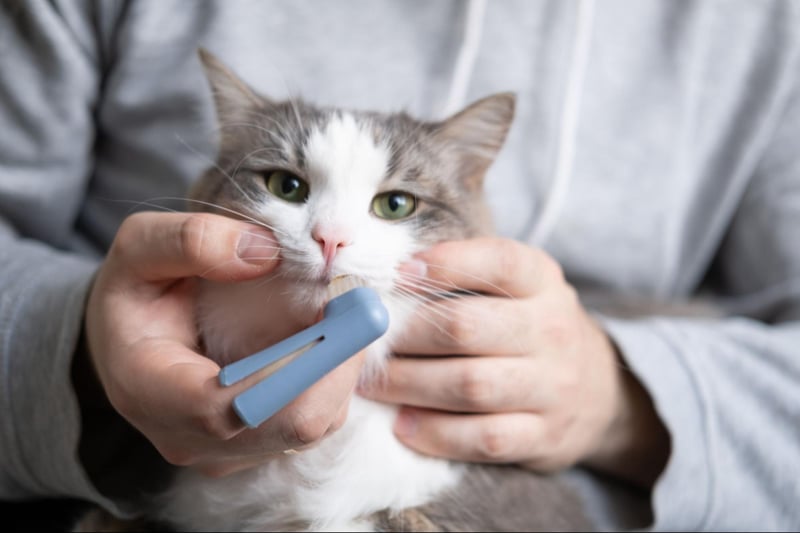
Taking care of your cat’s dental health starts at home. Incorporating regular cat dental care into your daily routine can significantly reduce your cat’s risk of developing dental problems and help them live happier and healthier lives. Without practicing cat dental care at home, your cat will need more frequent teeth cleanings, which can be expensive.
But thankfully, it’s relatively easy to get your cat onto a regular teeth cleaning routine:
- Daily tooth brushing slows the progression of dental disease in cats. While it’s recommended that you brush your cat’s teeth at least once if not twice in a day, at least three times a week is the minimum recommendation. You can use a regular human toothbrush, but some pet owners prefer a finger toothbrush (looks similar to a thimble with little bristles that are made of silicon) because they are small and easier to control, allowing you to get into all the nooks and crannies in your cat’s mouth. A regular toothbrush is great for removing plaque, but won’t help much with tartar buildup. If your cat has tartar, then it’s time to book them in for a cleaning at your vet.
- Dental rinses are also an option. While not as effective as brushing your cat’s teeth, dental rinses for cats are effective for removing some plaque and bacterial buildup and can provide protection against further bacterial development for hours. The rinse is applied by squirting a small amount inside your cat’s mouth near their cheeks on each side.
- There is also a special oral hygiene solution that can be added to cat’s water. Most oral water additive solutions are formulated to be completely flavourless so that your cat won’t realize that anything is in their water. It’s not usually recommended to use oral water additives for cats with a cat water fountain, especially if it has a filter, as the filter can remove the essential ingredients that make the product work properly.
- Dental chews can be effective for removing the buildup of plaque. Dental chews, which are sold as treats, are a great way to help remove excess plaque buildup on your cat’s teeth. Usually, these treats contain an enzyme or other ingredients like sodium hexametaphosphate that naturally and safely decreases plaque and tartar buildup. Plus, these treats are usually flavoured like any other cat treats with chicken or fish, so your cat will likely love eating them.
Cat Dental Care & Wellness Supplements
Aside from the techniques listed above for helping to remove plaque from your cat’s mouth, there are also cat dental care supplements that you can incorporate into your cat’s daily oral care routine. These supplements usually come in powdered form, so it’s easy to simply sprinkle it onto your cat’s regular food. Usually, dental care for cat supplements contains zeolites and propolis, which are minerals that help prevent plaque from forming and sticking to your cat’s teeth.
Speaking of dental health, another important part of cat bone structure is their joints. Given how much cats run, jump, and contort their bodies, maintaining their joint health is paramount to ensuring they have a high quality of life. As many as 60–90% of cats will experience joint degradation in their lifetime. One of the most effective preventative measures is giving your cat a daily joint cat supplement.
TRI-ACTA H.A. for Pets
Our maximum strength formula is optimally designed to accelerate the formation of cartilage, minimize inflammation, expedite the healing process, and improve joint conditions.

TRI-ACTA is a great choice. It contains 100% active ingredients, meaning you’re not wasting money on fillers, additives, and preservatives. Plus, it ensures you only need to give your cat a small amount of supplement daily. TRI-ACTA contains fully natural ingredients to support your cat’s joint health, including:
|
TRI-ACTA Ingredient |
Benefit |
|
Glucosamine Sulfate and HCl |
With these two types of glucosamine in one supplement, your cat will get the maximum possible benefit that glucosamine has to offer. |
|
Chondroitin |
|
|
Methylsulfonylmethane (MSM) |
|
|
Hyaluronic acid (available in TRI-ACTA H.A.) |
|
Senior Cat Dental Care Plan For Preventing Dental Issues
Although senior cats are more prone to dental issues, being old doesn’t necessarily mean that your cat will need special dental treatment or care. The same dental care cat routine that would be done for any cat should be applied to senior cats as well. This includes regular brushing, a high-quality diet, and regular dental check-ups.
Summary
The significance of dental care for cats mirrors our own oral hygiene needs. Neglecting a cat's dental health can lead to severe complications, from painful dental diseases to systemic issues affecting vital organs. The subtle signs of dental problems in cats make regular care and check-ups vital, as cats are adept at concealing pain. Recognizing the importance of preventive measures, like daily tooth brushing and incorporating supplements, is crucial in ensuring a cat's well-being. By embracing consistent dental care at home and through professional veterinary support, we pave the way for our feline companions to lead healthier, happier lives, free from the perils of untreated dental issues.
Taking preventative measures to ensure your cat’s continued health is important. Aside from regular dental care for cat, supporting your cat’s joint health is also important. TRI-ACTA is a great option for a daily joint care supplement with high-quality active ingredients you can trust.
Purchase TRI-ACTA online or learn where to buy at a store near you.
TRI-ACTA for Pets
A proactive approach for developing and younger adult pets to maintain optimal joint health mobility, minimize inflammation and fend off age-related ailments.
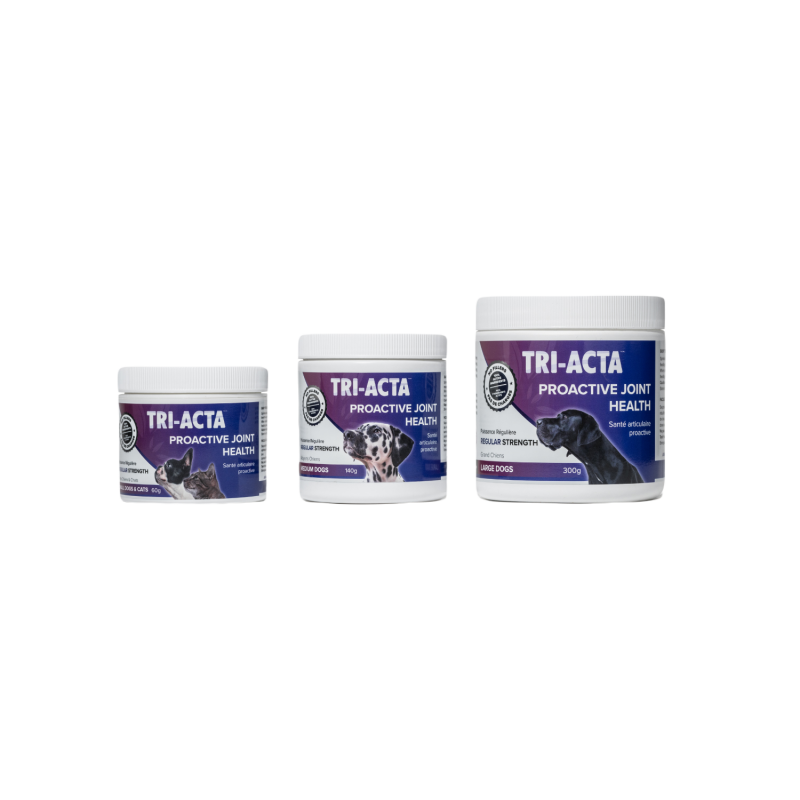
Newsletter Signup
Subscribe to our newsletter to receive the latest news and exclusive offers.
.jpg?height=2000&name=Cliick_Integricare-DISPLAY-REVISEDV2%20(1).jpg)
Proactive & Therapeutic Joint Supplements
When given daily, Integricare joint supplements recover bone and joint injuries faster and help prevent mobility injuries from happening in the first place.

